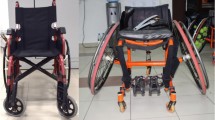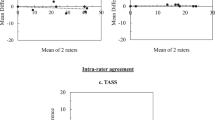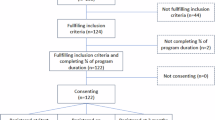Abstract
Study design:
Observational, cross-sectional.
Objectives:
A new classification system for trunk impairment in wheelchair rugby was introduced in 2010. It consists of 10 tests, arranged in an algorithm, to assign four different trunk scores (0, 0.5, 1.0 or 1.5) to athletes. The purpose of this study was to assess the inter-rater reliability of this classification system.
Setting:
National competition for wheelchair rugby and wheelchair basketball in the Netherlands and Belgium.
Methods:
Three experienced wheelchair rugby classifiers independently assigned trunk scores to wheelchair rugby and wheelchair basketball athletes in two sessions. After each session, test descriptions were adjusted. The inter-rater reliability was evaluated by determining the agreement and Fleiss Kappa.
Results:
In the first session, all classifiers agreed on the trunk score in 13 out of 16 athletes; the overall Kappa was 0.76 (P<0.001). The Kappa per trunk score ranged from 0.29 to 1. Four test descriptions were adjusted after the first session. In the second session, there was an agreement in trunk score between the classifiers in 15 out of 21 athletes. The overall Kappa was 0.75 (P<0.0001), and the Kappa per trunk scores ranged from 0.58 to 0.92. After the second session, two test descriptions were improved.
Conclusion:
The revised classification system for trunk impairment in wheelchair rugby showed a adequate inter-rater reliability for the allocation of trunk scores.
Similar content being viewed by others
Log in or create a free account to read this content
Gain free access to this article, as well as selected content from this journal and more on nature.com
or
References
Orr K, Malone LA . Wheelchair rugby. In: Goosey-Tolfrey VickyWheelchair sport. A complete guide for athletes, coaches and teachers. Human Kinetics 2010 pp 151–166.
Tweedy SM, Vanlandewijck YC . International Paralympic Committee position stand- Background and scientific rationale for classification in Paralympic sport. Br. J. Sports Med 2011; 45: 259–269 published online 22 Oct 2009.
Tweedy S, Howe DP . Introduction to the Paralympic movement. In: Yves C Vanlandewijck, Walther R Thompson (eds). The Paralympic athlete. Wiley Blackwell: Oxford, UK. 2011 pp p19–p29.
American Spinal cord Injury Association Impairment Scale Available from http://www.asia-spinalinjury.org/elearning/ISNCSCI_Exam_Sheet_r4.pdf.
International wheelchair rugby classification manual 3rd revised edition June 2011. Available from www.iwrf.com/resources/iwrf_docs/IWRF_Classification_Manual_3rd_Edition_rev-2011_(English).pdf.
Morgulec-Adamowicz N, Kosmol A, Molik B, Yilla AB, Laskin J . Aerobic, anaerobic and skill performance with regard to classification in wheelchair rugby athletes. Res Q Exerc Sport 2011; 82: 61–69.
Molik B, Lubelska E, Kosmol A, Bogdan M, Yilla AB, Hyla E . An examinaton of the international wheelchair rugby federation classification system utilizing parameters of offensive game efficiency. Adapt Phys Activ Q 2008; 25: 335–351.
Sarro KJ, Misuta MS, Burkett B, Malone LA, Barros RM . Tracking of wheelchair rugby players in the 2008 Demolition Derby final. J Sports Sci 2010; 13: 1–8.
Sporner ML, Grindle CG, Kelleher A, Teodorski EE, Cooper R, Cooper RA . Quantification of activity during wheelchair basketball and rugby at the National Veterans Wheelchair games: A pilot study. Prothet Orthot Int 2009; 333: 21–27.
Altmann VC, Hart AL, van Limbeek J, Vanlandewijck YL Improvement of the classification system for wheelchair rugby: athlete priorities. 5th IPC Vista conference 2011: A multi-disciplinary approach to Paralympic success. Conference proceedings http://www.paralympic.org/pidas/vista/2011_08_VISTA2011_Booklet.pdf.
Altmann VC, Hart A, Parkinson A Wheelchair rugby classification database: aid to the improvement of classification. 4th IPC Vista conference 2006. Classification: solutions for the future. Conference proceedings.
Washington L, Hart A Influence of Trunk on Wheelchair Propulsion: Using Evidence to Guide Classification System Review. 5th IPC Vista conference 2011: A multi-disciplinary approach to Paralympic success. Conference proceedings http://www.paralympic.org/pidas/vista/2011_08_VISTA2011_Booklet.pdf.
Wu SK . Classifiers and social control in wheelchair rugby. Kaohsiung J Med Sci 2001; 17: 90–98.
World medical association declaration of Helsinki, October 2008. Available from http://www.wma.net/en/30publications/10policies/b3/17c.pdf.
Landis JR, Koch GG . The measurements of observer agreement for categorical data. Biometrics 1977; 33: 159–174.
Potten YJM, Seelen HAM, Drukker J, Reulen JPH, Drost MR . Postural muscle responses in the spinal cord injured persons during forward reaching. Ergonomics 1999; 42: 1200–1215.
Janssen-Potten YJ, Seelen HA, Drukker J, Reulen JPH . Chair configuration and balance control in persons with spinal cord injury. Arch Phys Med Rehabil 2000; 81: 401–408.
Janssen-Potten YJ, Seelen HA, Drukker J, Huson T . The effect of seat tilting on pelvic position, balance control and compensatory postural muscle use in paraplegic subjects. Arch Phys Med Rehabil 2001; 82: 1393–1402.
Pernot HFM, Lannem AM, Geers RPJ, Ruijters EFG, Bloemendal M, HAM Seelen . Validity of the test-table-test for Nordic skiing for classification of paralypic sit ski sports participants. Spinal Cord 2011; 49: 935–941.
Chen CL, Yeung KT, Bih LI, Wang CH, Chien JC . The relationship between sitting stability and functional performance in patients with paraplegia. Arch Phys Med Rehab 2003; 84: 1276–1281.
Bjerkefors A, Carpenter MG, Cresswell AG, Thorstensson A . Trunk muscle activation in a person with clinically complete thoracic spinal cord injury. J Rehabil Med 2009; 41: 390–392.
Fujiwara T, Liu M, Tsuji T, Sonoda S, Mizuno K, Akaboshi K et al. Development of a new measure to assess trunk impairment after stroke (Trunk Impairment Scale): it’s psychometric properties. Am J Phys Med Rehabil 2004; 83: 681–688.
Heyrman L, Molenaers G, Desloovere K, Verheyden G, De Cat J, Monbaliu E et al. A clinical tool to measure trunk control in children with cerebral palsy: the Trunk Control Measurement Scale. Res Dev Disabil 2011; 32: 2624–2635.
Verheyden G, Nieuwboer A, Mertin J, Preger R, Kiekens C, De Weerdt W et al. The trunk impairment scale: a new tool to measure motor impairment of the trunk after stroke. Clin rehabil 2004; 18: 326–433.
Verheyden G, Nuyens G, Nieuwboer A, Van Asch P, Ketelaer P, De Weerdt W et al. Reliability and validity of trunk assessment for people with multiple sclerosis. Phys Ther 2006; 86: 66–76.
Acknowledgements
We thank all classifiers and athletes who participated in this study. We thank Gehandicaptensport Nederland and Hollister Nederland for contributing to the travel costs of the classifiers and the athletes.
Author information
Authors and Affiliations
Corresponding author
Ethics declarations
Competing interests
The authors declare no conflict of interest.
Additional information
Supplementary Information accompanies this paper on the Spinal Cord website
Supplementary information
Rights and permissions
About this article
Cite this article
Altmann, V., Groen, B., van Limbeek, J. et al. Reliability of the revised wheelchair rugby trunk impairment classification system. Spinal Cord 51, 913–918 (2013). https://doi.org/10.1038/sc.2013.109
Received:
Revised:
Accepted:
Published:
Issue date:
DOI: https://doi.org/10.1038/sc.2013.109
Keywords
This article is cited by
-
Overground vs. treadmill-based robotic gait training to improve seated balance in people with motor-complete spinal cord injury: a case report
Journal of NeuroEngineering and Rehabilitation (2017)
-
Elite wheelchair rugby: a quantitative analysis of chair configuration in Australia
Sports Engineering (2016)
-
Diagnostic accuracy of common clinical tests for assessing abdominal muscle function after motor-complete spinal cord injury above T6
Spinal Cord (2015)



